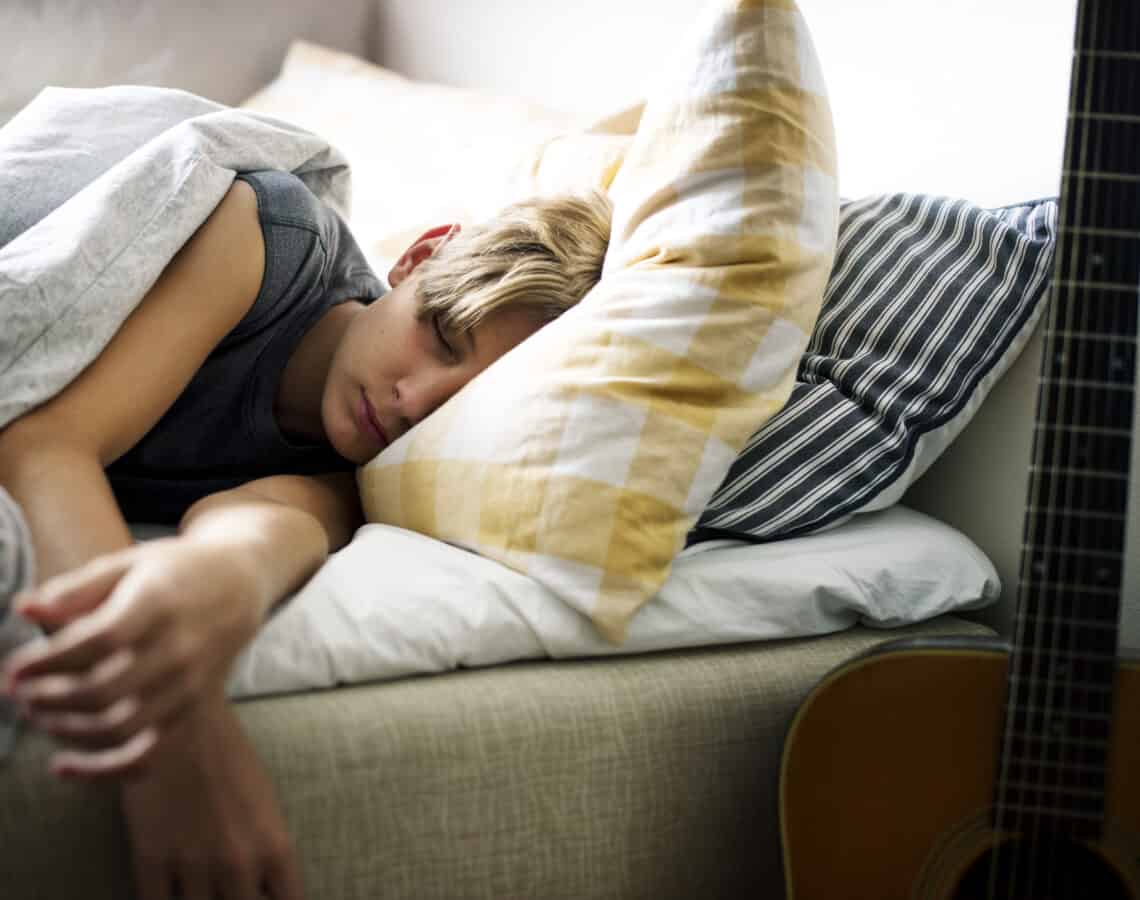Creating healthy teen sleep habits: a guide for parents of teenagers

Anyone having trouble getting teenagers to sleep? To fall asleep, stay asleep or achieve a decent sleep? Sleep is such an important aspect of overall health and wellbeing – it’s a time where we can recharge the brain and reduce our mental load, but getting a good and restorative sleep isn’t always easy. Teenagers, like babies and children, need even more sleep than adults for growth and development, so let’s talk about how to make their journey to dreamland as smooth and enjoyable as possible.
If your teenager is among the many people who could do with tweaking their sleeping patterns, here are some handy reminders.
How much sleep do we need?
Sleep is an essential ‘nutrient’ for the human body like air, sunlight and water.
According to the Australian Institute of Family Studies, around 25% of 12–15 year-olds, and 50% of 16-17 year-olds, are not getting enough sleep on school nights. They often catch up by sleeping longer on weekends.[2]
The Australian Department of Health recommends that teenagers aged 14–17 years should get 8–10 hours of uninterrupted sleep; and those aged 12–13 years need between 9–11 hours.[3]
This compares with adults who need between 7–9 hours .[4]
Why is sleep so important for teenagers?
For teens, good quality sleep is important for school performance, daily mood, and physical health.[5]
Sufficient sleep can help teenagers think more clearly in school and get along better with peers.[6] Stress and depression can be reduced through sleep and improve a teenager’s mood.[7]
Is your teenager sleep deprived?
Find out by chatting to your teen and asking them about how they are sleeping.
During adolescence, teenagers do experience natural changes to sleep patterns, where they may not feel tired until later in the evening than they did before. Other changes such as an increase in school work, possible part-time/casual work and increased time spent on social media can all affect sleep.
When a teenager is experiencing good quality sleep, they will fall asleep quickly after going to bed and sleep right through the night. If they do wake up, they fall back to sleep within 20 minutes. Each morning they’re ready to face the day without feeling the need to sleep more and are energetic throughout the day.[8]
Maintaining a healthy weight through sleep
Short sleep duration, poor sleep quality and later bedtimes are all associated with an increased food intake, poor quality diet and excess body weight.[9]
This is due to more time and opportunities for eating; mental distress; increased sensitivity to food rewards; eating without restriction; and changes in appetite hormones.[10]
Increased food intake and excess body weight may lead to metabolic disorders and an increased risk of obesity or other chronic health conditions.
Busy schedules can impact teenagers from getting enough sleep. Creating heathy sleep habits is key for positive mental health, but also for long-term healthy weight.
Creating a sanctuary for sleep
The Sleep Foundation tips for improving your sleep quality are[11]:
- Keep a regular and consistent bedtime and wake-up schedule
- Maintain a good sleep environment. Keeping your bedroom dark, at a comfortable temperature and without devices
- Avoid having screens in the bedroom and avoid screen time an hour before sleep. Artificial light form screens can throw sleep routines and impact sleep quality[12]
- Limit your caffeine, alcohol, and smoking, as these contribute to poor sleep
- Encourage an afternoon nap. Early afternoon napping for 15–20 minutes could be beneficial to reduce daytime sleepiness and improve daily performance.
A study of high school students also found that sleep duration improved with >60min of physical activity improved sleep duration and <2hours of video or computer gaming each day.[13]
If you are looking for more support and tailored guidance, be sure to consult your local general practitioner.
This blog was contributed to by Jiaqi He, Masters of Dietetic Student, University of Queensland, as part of their coursework placement with Health and Wellbeing Queensland, 2022.
References
[1] World Sleep Day (https://worldsleepday.org/)
[2] Australian Institute of Family Studies, Are Children and adolescents getting enough sleep? 2018 https://aifs.gov.au/sites/default/files/2022-03/5608-children-adolescents-enough-sleep.pdf
[3] Australian Institute of Family Studies: Promoting adequate sleep in young people
[4] The Sleep Foundation: How much sleep do we really need? (https://www.sleepfoundation.org/how-sleep-works/how-much-sleep-do-we-really-need)
[5] Getting enough sleep (https://health.gov/myhealthfinder/healthy-living/mental-health-and-relationships/get-enough-sleep)
[6] Promoting adequate sleep (https://aifs.gov.au/resources/short-articles/promoting-adequate-sleep-young-people#:~:text=The%20Australian%20Department%20of%20Health,up%20times%20are%20also%20recommended)
[7] Sleep and mental wellbeing: exploring the links (https://www.vichealth.vic.gov.au/-/media/ResourceCentre/PublicationsandResources/Mental-health/Summary-sleep-and-wellbeing-summary-report.pdf)
[8] Chaput, J. P. (2014). Sleep patterns, diet quality and energy balance. Physiology & Behaviour, 134, 86-91.
[9] How to determine poor sleep quality (https://www.sleepfoundation.org/sleep-hygiene/how-to-determine-poor-quality-sleep)
[10] The Sleep Foundation: Weight Loss and Sleep (https://www.sleepfoundation.org/physical-health/weight-loss-and-sleep
[11] How to determine poor sleep quality (https://www.sleepfoundation.org/sleep-hygiene/how-to-determine-poor-quality-sleep)
[12] Australian Government Department of Health and Aged Care (2021 May 6), For children and young people (5 to17 years).
[13] Foti, K. E., Eaton, D. K., Lowry, R., & McKnight-Ely, L. R. (2011). Sufficient sleep, physical activity, and sedentary behaviours. American journal of preventive medicine, 41(6), 596-602.
[14] Styne, D. M., Arslanian, S. A., Connor, E. L., Farooqi, I. S., Murad, M. H., Silverstein, J. H., & Yanovski, J. A. (2017). Pediatric obesity—assessment, treatment, and prevention: an Endocrine Society clinical practice guideline. The Journal of Clinical Endocrinology & Metabolism, 102(3), 709-757.


